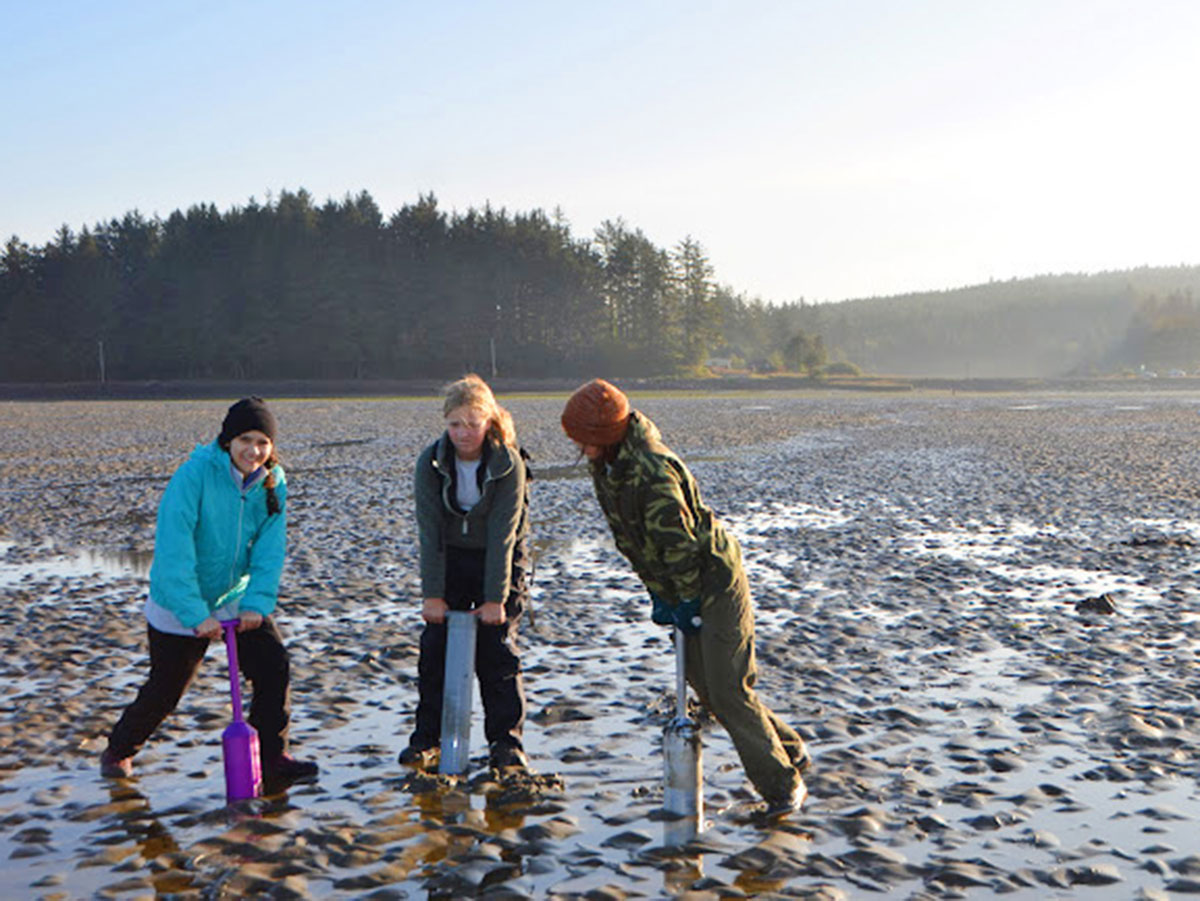Oregon Scouts Try Crabbing and Clamming

From left: Lucy Morris, Collette Anderson and Mia Jensen dig for clams. Clams burrow into the sand, and they can be quick when they sense danger.
Scouts gathered around a table at camp. Before them was a fantastic feast: boiled corn, potatoes, shrimp, sausage and pasta with their choice of marinara or creamy white sauce. But the main dishes were what the Scouts caught earlier that day: crabs and clams.
Crabbing and clamming were new activities for Troop 555 of West Linn, Oregon. They didn’t have to travel far to try it. After a short drive west from their Portland suburb, the Scouts pitched their tents at Camp Meriwether, which sits close to several coastal bays, perfect places to hunt for seafood.

Right: Lucy Morris shows off a cockle mollusk she found. In the background is Scoutmaster Keith Morris. Left: Mia Jensen uses a clam gun.
FEELING CLAMMY
Low tide is the best time to search for clams. The troop woke up at 7 a.m., prepared to collect them.
“We had to bring waterproof boots. We had to bring clam shovels,” says Annie Morris, 14, a Life Scout. “We definitely had to bring buckets.”
Other tools they brought were clam guns. No, they weren’t going to blast mollusks out of the muck. A clam gun is a long tube you press into the ground to pull up columns of sand that hopefully have clams inside.

Abby Sheedy, Mia Jensen and assistant Scoutmaster Kylie Akita use clam guns to pull out sections of sand.
“You pull it up, and then you dig with your hands really fast,” says Lucy Morris, 12, a First Class Scout. “The mud was sticky — it’d get in your fingernails.”
Even if you get a clam, it doesn’t mean you can keep it. State laws dictate the limits for species and quantities you can gather. It’s important to know those laws and to have a proper license with you. The girls collected a few dozen clams before the tide returned.
“I was watching the water to make sure we weren’t out too long,” says Life Scout Claire Rainey, 17.

Windsor Layne found this sea snail shell on the beach.
IN A PINCH
After lunch, the Scouts headed over to a marina to go crabbing. They were briefed on safety and regulations: Only male crabs that were more than 5¾ inches wide could be collected; females must be tossed back to help sustain the population.
They took turns riding a boat over to traps that were already baited with stinky fish heads and chicken wings. The bait attracted the crabs, which could still crawl away, so the Scouts had to quickly lift the traps. They pulled up a lot of females, but after a few hours, they had collected quite a few large male crabs.

Clamming can be a dirty job! Lucy Morris rinses her hands off. Before going clamming, check with the local health department on proper handling and if there are any contamination warnings in the area.
“There’s only a certain amount of time that you can keep a crab alive before you cook it,” says Audrey Tsai, 16, a Life Scout. “We had the marina cook them.”
Meanwhile, the clams could stay in a cooler of saltwater, and they’d be fine to prepare at camp.
LET’S PARTY
With their seafood in hand, the troop headed back to camp, where they made a delicious meal. In addition to the seafood boil, they made Dutch-oven strawberry shortcake and cinnamon rolls with cream-cheese frosting.

The Scouts enjoyed a seafood dinner.
That weekend was Annie’s birthday, so they celebrated by going on a fun scavenger hunt, which led them to one of the covered shelters in camp they had decorated for the occasion.
The Scouts enjoyed the crabbing and clamming campout. It wasn’t just the great food; they also learned a lot about nature.
“I’m interested in environmental science. I’m glad I tried it,” Annie says. “It was cool to harvest it and then eat it. The main thing I learned was to always follow the seagulls — they knew where the good stuff was.”

The group poses with the clams they found.
Leave a Comment